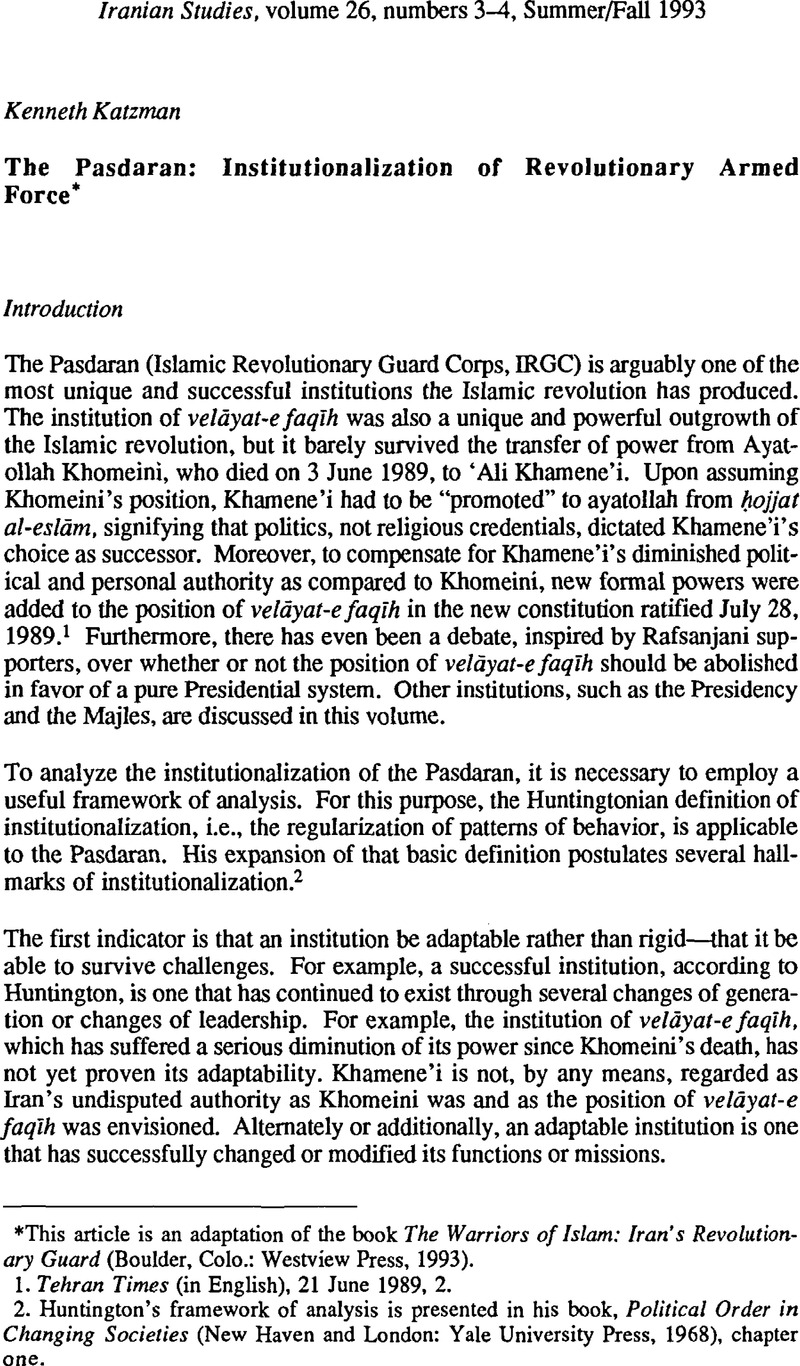Published online by Cambridge University Press: 01 January 2022

This article is an adaptation of the book The Warriors of Islam: Iran's Revolutionary Guard (Boulder, Colo.: Westview Press, 1993).
1. Tehran Times (in English), 21 June 1989, 2.
2. Huntington's framework of analysis is presented in his book, Political Order in Changing Societies (New Haven and London: Yale University Press, 1968), chapter one.
3. For a further discussion of the Syrian regime, see Kessler, M., Syria: Fragile Mosaic of Power (Washington, D.C.: National Defense University, 1987)Google Scholar.
4. Chorley, K., Armies and the Art of Revolution (Boston: Beacon Press, 1973)Google Scholar. See especially chapters 11 and 12.
5. Interview with Mohsen Rafiqdust, in Tehran Eṭṭelā'āt, 22 September 1985, 4.
6. Mission, Record of Revolution Guard Corps Reviewed, Iran Press Digest, 15 June 1982, in Joint Publication Research Service, 12 July 1982, 38.
7. “The Present Position of the Revolutionary Guards,” Echo of Iran (Tehran), 18 October 1988.
8. Reza'i on establishment of new IRGC staff command, domestic service in Persian (Tehran), 28 September 1989.
9. “Firuzabadi Appointed Chief of General Staff,” Tehran television service, 26 September 1989. The text of Khamene'i's announcement of Firuzabadi's appointment refers to him as “brother Basiji,” a clear reference to his links to the Pasdaran.
10. The commander of the Qods unit, the umbrella Pasdaran organization for its export of the revolution apparatus abroad, was identified by the Iranian press as Pasdaran major-general Vahidi, during coverage of a memorial service for Hizballah leader ‘Abbas Musawi. (Musawi died in an Israeli helicopter attack in February 1992.) Vahidi is formally superior to the commanders of Pasdaran contingents abroad. The commander of the Pasdaran's Lebanon contingent, for example, is Reza ‘Askari (“Lebanese Hizballah Leader Vows to Destroy U.S.,” Voice of the Islamic Republic of Iran [Tehran], 2 March 1992).
11. “New Appointments to Various Ministries Announced,” London Kayhān (in Persian), 2 January 1990, 2.
12. Selhami, M., “I Met the Suicide Men,” Jeune Afrique (Paris), 25 January 1984, 41–51Google Scholar.
13. “New Air Force Includes 100 Iraqi Aircraft,” al-Sharq al-awsaṭ (London), 2 December 1991, 1.
14. “IRGC Air Force Begins Missile Training,” Tehran domestic service, 25 February 1988; “Rafsanjani Attends IRGC Graduation Ceremony,” Islamic Republic News Agency (in English), 12 October 1988.
15. “Amphibious Personnel Carrier Manufactured,” Tehran television service, 1 February 1988; “Guard Corps Minister on Military Self-Sufficiency,” Tehran domestic service, 8 November 1987; “IRGC Minister Announces Launching of New Tugboat,” IRNA (in English), 24 November 1987; “Reza'i: New Tank Under Manufacturing, Three New Planes Tested,” IRNA (in English), 7 November 1987; “First Hover craft Manufactured by IRGC,” Tehran domestic service, 6 February 1989; “Musavi Hears Report on New Helicopter,” Tehran domestic service, 11 April 1989.
16. “Iranian Bomb,” Washington Post, 12 January 1992, C7; “Shipment of U.S. Chemical Seized on Way to Iran,” New York Times, 23 March 1989, A13. It is widely acknowledged that Iran has a nuclear research program, but U.S. and international analysts are divided over whether or not it possesses a nuclear weapons program. An inspection visit by the International Atomic Energy Agency in February 1992 found no evidence, at the six sites visited at the time, of any violations of Iran's obligations under the Nuclear Non-Proliferation Treaty, to which Iran is a party.
17. Akhbār (News), vol. K, no. 141, 17 September 1988. 18 For a discussion of Pasdaran relations with Afghan Shi'a groups during the war against the Soviet occupation, see J. Rupert, “Rebels Say Iran Seeks Control of Insurgency,” Washington Post, 8 October 1986, Al.
19. U.S. Department of State, “Patterns of Global Terrorism: 1992,” released April 1993.
20. Excerpts from an interview with Kazem Bojnurdi in Jomhūrī-ye Eslām, repr. in The Flame, 1 July 1980. The Pasdaran's first operational commander, ‘Abbas Zamani, had also been a member of the Islamic nations party.
21. “Article Recounts 10 Years of Khomeyni Terrorism,” Lettre persane (Paris), no. 46 (June 1986): 6–10.
22. Y. Ibrahim, “Iran Shifting Its Attention from Lebanon to Sudan,” New York Times, 13 December 1991, A7.
23. In early August 1993, Rafsanjani, at the beginning of his second term as president, nominated ‘Ali Mohammad Besharati to replace Nuri as interior minister. Besharati was an anti-shah guerrilla who became chief of Pasdaran intelligence and a member of the Pasdaran's commanders council after the revolution. He subsequently ran for the Majles and became deputy foreign minister in 1984. While at the foreign ministry, he has been considered close to Rafsanjani.
24. “Khamene'i Warns Against Enemy, Vice,” Voice of the Islamic Republic of Iran, 21 October 1992.
25. “Commander Interviewed on Start of Basij Week,” Voice of the Islamic Republic of Iran, 19 November 1992.
26. “Militia Mobilized to Halt Urban Unrest,” Agence France Presse (in English), 17 June 1992.
27. Some evidence of the desire of the pragmatists to cut back these activities is provided by Rafsanjani's speech inaugurating his second term as president, in which he said that Iran should not be interested in foreign activism. Other evidence was provided by a reported Kuwaiti newspaper interview with foreign minister Velayati, in which Velayati reportedly said he would attempt to purge Pasdars and other hardliners from Iran's foreign embassies. See “Velayati Planning Purge of Embassy Hardliners,” Sawt al-Kuwayt al-duwali (London), 9 May 1992.
28. “Shift by Shi'ites Seen Speeding Release of Western Hostages,” Washington Post, 21 Novemberl991, A44.
29. “Syrian-Iran Arms Pact,” The Middle East Today, no. 111 , 3 October 1991.
30. U.S. Department of State, “Patterns.“
31. Ibid.
32. Wright, R., Sacred Rage: The Crusade of Militant Islam (New York: Linden Press/Simon and Schuster, 1985), 89Google Scholar.
33. Foreign minister Velayati has acknowledged that there are “a few hundred” Pasdars in Sudan but that they were in Sudan to perform “construction work.“
34. S. Meddis, “Expert: Iranian Ties Are Growing Stronger,” U.SA. Today, 25 March 1993, 3A.